
SON-30 (NATO reporting name Fire Wheel) is a type of Russian/Soviet fire director radar for 130 mm anti-aircraft guns. [1] It was a Soviet derivative of the US SCR-584 system. [2]

SON-30 (NATO reporting name Fire Wheel) is a type of Russian/Soviet fire director radar for 130 mm anti-aircraft guns. [1] It was a Soviet derivative of the US SCR-584 system. [2]

Anti-aircraft warfare, counter-air, anti-air, AA guns, layered air defence or air defence forces is the battlespace response to aerial warfare, defined by NATO as "all measures designed to nullify or reduce the effectiveness of hostile air action". It includes surface based, subsurface, and air-based weapon systems, associated sensor systems, command and control arrangements, and passive measures. It may be used to protect naval, ground, and air forces in any location. However, for most countries, the main effort has tended to be homeland defence. NATO refers to airborne air defence as counter-air and naval air defence as anti-aircraft warfare. Missile defence is an extension of air defence, as are initiatives to adapt air defence to the task of intercepting any projectile in flight.
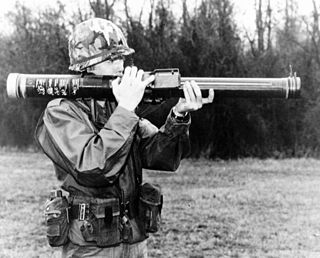
Anti-tank warfare originated from the need to develop technology and tactics to destroy tanks during World War I. Since the Allies deployed the first tanks in 1916, the German Empire developed the first anti-tank weapons. The first developed anti-tank weapon was a scaled-up bolt-action rifle, the Mauser 1918 T-Gewehr, that fired a 13.2 mm cartridge with a solid bullet that could penetrate the thin armor of tanks at that time and destroy the engine or ricochet inside, killing occupants. Because tanks represent an enemy's strong force projection on land, military strategists have incorporated anti-tank warfare into the doctrine of nearly every combat service since. The most predominant anti-tank weapons at the start of World War II in 1939 included the tank-mounted gun, anti-tank guns and anti-tank grenades used by the infantry, and ground-attack aircraft.

The 8.8 cm Flak 18/36/37/41 is a German 88 mm anti-aircraft and anti-tank artillery gun, developed in the 1930s. It was widely used by Germany throughout World War II and is one of the most recognized German weapons of the conflict. The gun was universally known as the Acht-acht ("eight-eight") by the Germans and the "eighty-eight" by the Allies. Due to its lethality, especially as a tank killer, the eighty-eight was greatly feared by Allied soldiers.

The siege of Sevastopol also known as the defence of Sevastopol or the Battle of Sevastopol was a military engagement that took place on the Eastern Front of the Second World War. The campaign was fought by the Axis powers of Germany and Romania against the Soviet Union for control of Sevastopol, a port in Crimea on the Black Sea. On 22 June 1941 the Axis invaded the Soviet Union during Operation Barbarossa. Axis land forces reached the Crimea in the autumn of 1941 and overran most of the area. The only objective not in Axis hands was Sevastopol. Several attempts were made to secure the city in October and November 1941. A major attack was planned for late November, but heavy rains delayed it until 17 December 1941. Under the command of Erich von Manstein, Axis forces were unable to capture Sevastopol during this first operation. Soviet forces launched an amphibious landing on the Crimean peninsula at Kerch in December 1941 to relieve the siege and force the Axis to divert forces to defend their gains. The operation saved Sevastopol for the time being, but the bridgehead in the eastern Crimea was eliminated in May 1942.

The ZU-23-2, also known as ZU-23, is a Soviet towed 23×152 mm anti-aircraft twin-barreled autocannon. ZU stands for Zenitnaya Ustanovka – anti-aircraft mount. The GRAU index is 2A13.

The QF 3.7-inch AA was Britain's primary heavy anti-aircraft gun during World War II. It was roughly the equivalent of the German Flak 8.8 cm and American 90 mm, but with a slightly larger calibre of 3.7 inches, approximately 94 mm. Production began in 1937 and it was used throughout World War II in all theatres except the Eastern Front. It remained in use after the war until AA guns were replaced by guided missiles beginning in 1957.

The Oerlikon GDF or Oerlikon 35 mm twin cannon is a towed anti-aircraft gun made by Oerlikon Contraves. The system was originally designated 2 ZLA/353 ML but this was later changed to GDF-001. It was developed in the late 1950s and is used by around 30 countries.

The S-75 is a Soviet-designed, high-altitude air defence system. It is built around a surface-to-air missile with command guidance. Following its first deployment in 1957 it became one of the most widely deployed air defence systems in history. It scored the first destruction of an enemy aircraft by a surface-to-air missile, with the shooting down of a Taiwanese Martin RB-57D Canberra over China on 7 October 1959 that was hit by a salvo of three V-750 (1D) missiles at an altitude of 20 km (65,600 ft). This success was credited to Chinese fighter aircraft at the time to keep the S-75 program secret.
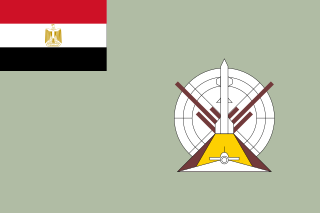
The Egyptian Air Defence Forces or EADF, is the Anti-aircraft warfare branch of the Egyptian Armed Forces. It is responsible for protecting the Egyptian airspace against any hostile air attacks. The EADF was established in accordance with the presidential decree issued on 1 February 1968, which established the Air Defence Forces as the fourth branch, next to the Navy, Egyptian Ground Forces, and Egyptian Air Force. From 1938 onwards air defence forces had been part of the artillery and under the operation command of the Air Force. Egypt has a modern system of air defence armament, which is divided between anti-aircraft missiles long, medium and short-range anti-aircraft artillery systems and early warning radars. Both Western and Soviet bloc countries have supplied equipment.

The 100 mm field gun M1944 (BS-3) is a Soviet 100 mm anti-tank and field gun.
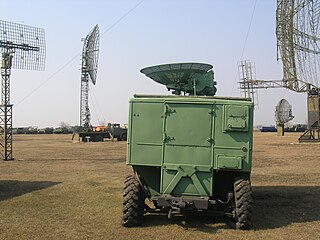
SON-9 is a type of Russian/Soviet fire director radar for air defence guns including the 57 mm, 85mm, and 100 mm, and 130mm anti-aircraft guns. The design was based on an older SON-4 Soviet design that was in turn based on a US-origin SCR-584 system, the plans for which were provided to the USSR during the second world war. It was used in combination with the PUAZO 6/60 fire director.

The 37 mm automatic air defense gun M1939 (61-K) is a Soviet 37 mm calibre anti-aircraft gun developed during the late 1930s and used during World War II. The land-based version was replaced in Soviet service by the AZP S-60 during the 1950s. Guns of this type were successfully used throughout the Eastern Front against dive bombers and other low- and medium-altitude targets. It also had some usefulness against lightly armoured ground targets.
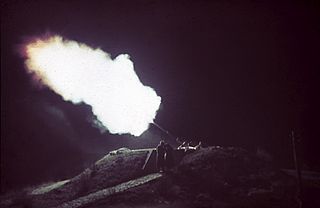
Helsinki, the capital of Finland, was bombed repeatedly during World War II. Between 1939 and 1944, Finland was subjected to a number of bombing campaigns by the Soviet Union. The largest were three raids in February 1944, which have been called The Great Raids Against Helsinki.

AZP S-60 is a Soviet towed, road-transportable, short- to medium-range, single-barrel anti-aircraft gun from the 1950s. The gun was extensively used in Warsaw Pact, Middle Eastern and South-East Asian countries.

The KS-19 100mm anti-aircraft gun is a Soviet anti-aircraft gun that also features good capabilities against ground targets.
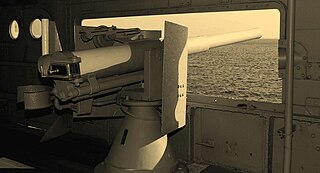
The QF 12-pounder 12-cwt gun (Quick-Firing) was a common, versatile 3-inch (76.2 mm) calibre naval gun introduced in 1894 and used until the middle of the 20th century. It was produced by Armstrong Whitworth, Elswick and used on Royal Navy warships, exported to allied countries, and used for land service. In British service "12-pounder" was the rounded value of the projectile weight, and "12 cwt (hundredweight)" was the weight of the barrel and breech, to differentiate it from other "12-pounder" guns.

The ZSU-23-4 "Shilka" is a lightly armored Soviet self-propelled, radar-guided anti-aircraft weapon system (SPAAG). It was superseded by the 9K22 Tunguska.

The South African Army Air Defence Artillery Formation is the controlling entity of all South African Army Air Defence Artillery units. This Formation consists of both regular and reserve units.
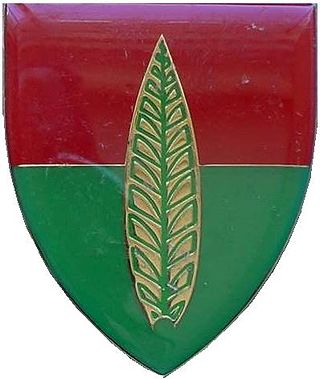
10 Anti-Aircraft Regiment is an anti-aircraft artillery regiment of the South African Army.

The 3rd Guards Anti-Aircraft Artillery Division was an anti-aircraft artillery division of the Soviet Union's Red Army during World War II and the Soviet Army during the early years of the Cold War.